Enterprises ready for the future need excellent change adoption practices.
Even though technology implementation needs high-level project management skills, the intended benefits and desired outcomes of user adoption of new change management strategies are immense.
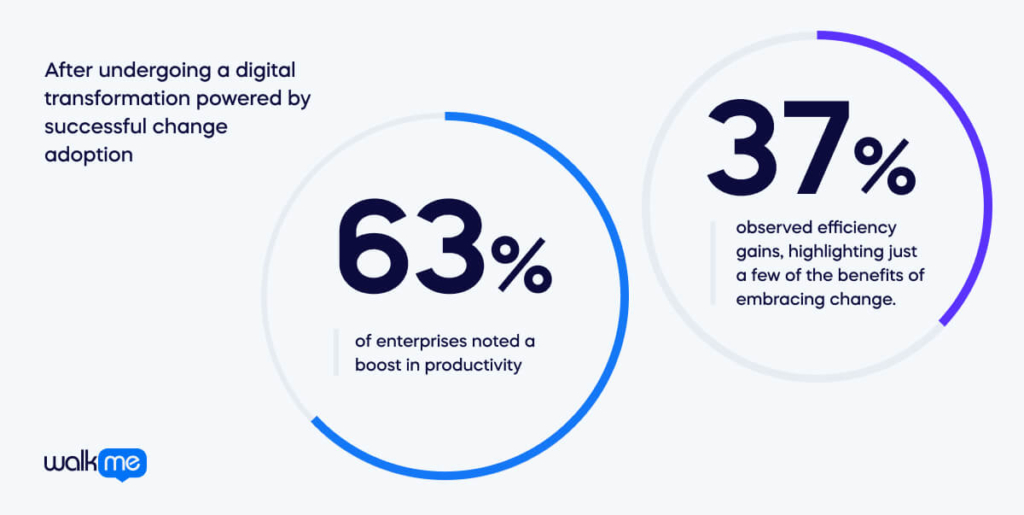
After undergoing a digital transformation powered by successful change adoption, 63% of enterprises noted a boost in productivity, while 37% observed efficiency gains, highlighting just a few of the benefits of embracing change.
However, the technical side of the successful change management process and digital adoption is only part of the challenge. For many organizations, not everyone will understand the benefits of a new way of doing things.
Such people need convincing to change their behavior, and this training and persuasion process will constitute the project’s major effort.
This article will examine how companies of any size can improve their organizational change and adoption processes.
To help you understand and implement the key steps to successful change adoption, we will explore the following topics:
- What is change adoption?
- How to implement a step-by-step enterprise change adoption plan
- How to drive change adoption with a digital adoption platform (DAP)
What is change adoption?
Change adoption, sometimes referred to as change management adoption, refers to the process by which individuals, teams, or organizations transition and fully embrace new methods, systems, technologies, or behaviors after a change initiative has been introduced.
It is a systematic approach to dealing with change that facilitates the digital assimilation of new technologies, workflows, organizational structures, customer experiences, or any change project.
Change adoption ensures the success and stickiness of new digital applications or workflows by employing in-app guidance, self-help user support, user behavior analytics, behavior modification, and reinforcement nudges.
Adopting change adoption practices can help an organization be more agile and responsive to change as well as ensuring changes are implemented effectively and efficiently.
How to implement a step-by-step enterprise change adoption plan
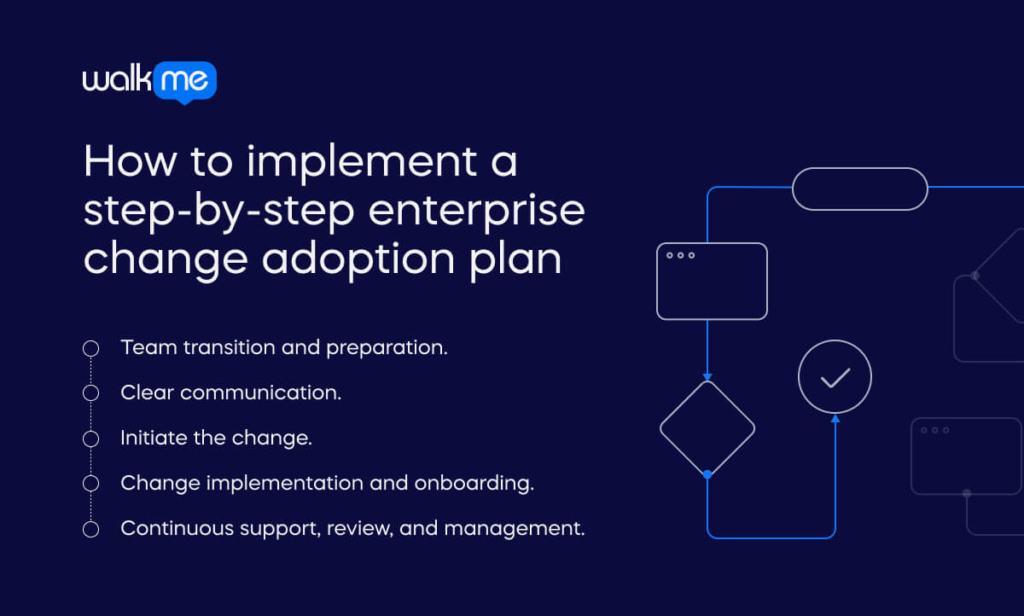
Enterprises aiming to expedite change adoption must concentrate on five pivotal stages:
- Team transition and preparation.
- Clear communication.
- Initiate the change.
- Change implementation and onboarding.
- Continuous support, review, and management.
1. Team transition and preparation
CIOs play a crucial role in preparing for a change initiative by understanding its necessity, defining change objectives, forming a change team to determine leadership and required skill sets, and assigning responsibilities for ensuring business process adoption.
This first step involves mapping current-state processes, researching best practices from similar change projects, and bringing in talent to ensure project success.
2. Clear communication

Enterprises must communicate impending changes well to gauge resistance, allow end-users and customers time to adjust, and collect feedback as one of the most effective change management strategies in the change process.
This step ensures CIOs gather vital information from those most affected, integrate suggestions, and include them in the change project.
3. Initiate the change
During the launch phase, design the IT roadmap for successful implementation and release. Set a launch date in advance, with dedicated IT team members ready to address any issues.
A smaller beta launch before the full release can help identify unexpected bugs or issues.
4. Change implementation and robust onboarding
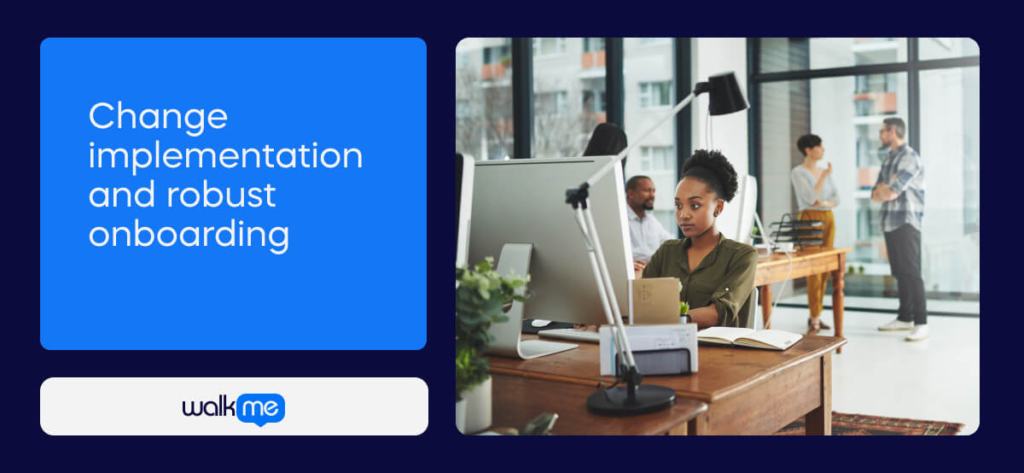
Empowering end-users, employees, and customers with guidance, upskilling, and end-user support for swift adoption is critical to adoption.
Allocate resources for IT support, contextual user guidance, and diverse training materials.
As digital enablement strategies evolve, organizations should invest in frameworks to accelerate change and support digital adoption.
There is still room for improvement in onboarding practices at many enterprises, as 76% of HR leaders say onboarding practices are not utilized enough at their organizations.
5. Continuous support, review and management
For any change project, establish digital transformation goals and KPIs to measure success and identify and course-correct issues promptly to manage change using experienced project managers.
Invest in a product analytics platform to understand user adoption of new processes, workflows, and software, ensuring ongoing success via continuous improvement.
How to drive change adoption with a digital adoption platform (DAP)
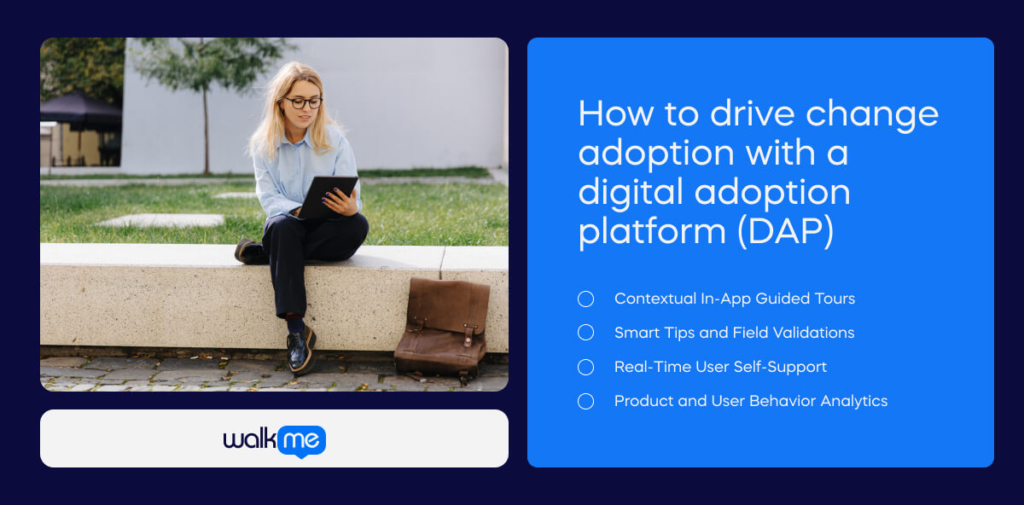
A digital adoption platform (DAP), empowers enterprises to bolster change projects by facilitating the engagement of customer and employee end-users.
A DAP, a no-code platform, allows the creation, launch, and analysis of learning management system implementation via in-app guidance, training, and upskilling of end-users, provision of self-help user support, collection of in-app feedback, and analysis of user behavior and product usage.
Here’s how a DAP enhances enterprise change management adoption strategies.
1. Contextual In-App Guided Tours
With WalkMe, craft in-app guided overlays aiding users in learning a product’s interface, capabilities, and contextual tasks.
For instance, during the implementation of a new CRM for the sales team, personalized guided onboarding tours and interactive walkthroughs can be created for distinct end-user types, ensuring relevance to their roles and workflows.
2. Smart Tips and Field Validations
Utilize a DAP to generate in-app tips and pop-ups communicating company messages, process changes, and task updates.
Smart tips provide end-users with updates on workflow changes, offering contextual information and field validations to guide adherence to guidelines, ensuring data quality and compliance.
Source: WalkMe Digital Adoption Report 2022-23
Many organizations lack a digital adoption strategy, which is crucial for the successful implementation of new digital technologies in their change adoption efforts.
3. Real-Time User Self-Support
Integrate a self-help wiki into your digital workplace through a DAP, allowing end-users to access FAQs, knowledge bases, user documentation, video tutorials, and training seamlessly.
This self-help wiki caters to user types, offering contextual support articles and how-to documentation to deflect standard support tickets and facilitate efficient workflows.
4. Product and User Behavior Analytics
WalkMe’s product analytics capabilities empower IT teams and CIOs with data-driven insights for change and digital adoption decisions.
This no-code platform facilitates user event tracking, providing insights into product usage, user journeys, engagement, and more.
Analyze user flows, identify friction points, create user cohorts, and track the adoption of change projects and digital applications.
Change adoption best practices
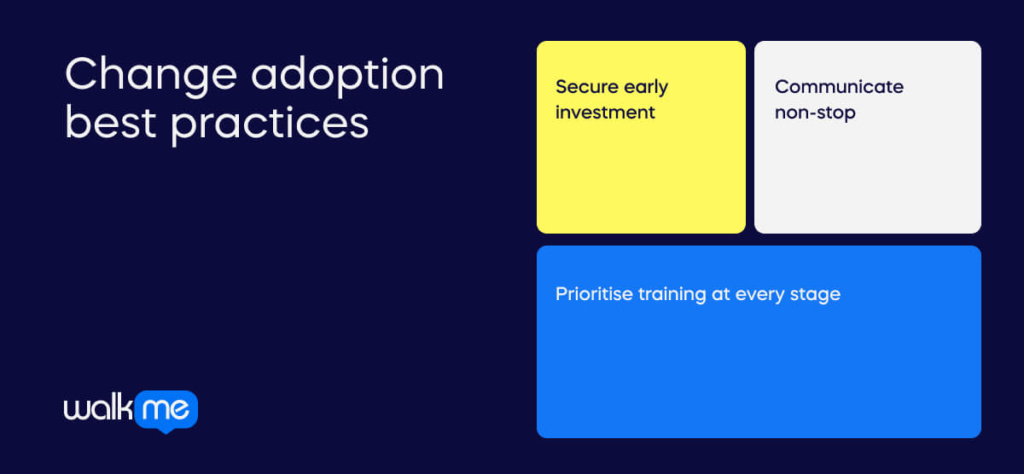
When following the above steps, it’s also helpful to use these ices to guide you along the path to change adoption success.
Secure early investment
Engage key stakeholders right from the initiation of the process.
Whether they partake in interviews and collaborative sessions, serve on advisory boards, or play a more tangible role, involve those responsible for implementation and users in the early stages, and secure stakeholder support as early as possible.
This action often includes marketing, sales, and service line managers. Incorporate the user community and establish advocates.
Communicate non-stop
Consistently, widely, and frequently articulate the purpose and expected outcomes. Set the expectation that adoption is non-negotiable, but that employees can ask questions about changes through several channels.
Ensure the entire organization comprehends the vision and intent. Tailor messages for each audience and utilize peer advocates for delivery.
Employing various channels—relying solely on email and corporate memos won’t suffice to involve stakeholders and successfully implement the change with long-term buy-in.
Treat it like a new introduction; you wouldn’t launch a game-changing product with a marketing automation email blast.
Prioritise training at every stage
Establish a 12 to 24-month program for current team members and integrate the model into new hire onboarding, hiring external change management professionals if necessary.
Ensure new and existing team members grasp the new operating model and its impact on them. Sustain training until remnants of old operational methods no longer persist.
Focus on employee experience for successful change adoption
Prioritizing employee experience is pivotal for successful change adoption. A positive employee experience ensures seamless transitions during changes, fostering engagement and employee productivity as they fully adopt changes in the long term.
Incorporating user-friendly tools, providing comprehensive training, and fostering open communication channels contribute to a supportive environment and a successful adoption process.
When employees feel valued and equipped for change, organizations experience smoother transitions and higher success rates in implementing new technologies and processes.
As a direct result of this shift, an organization’s culture moves toward accepting change and becoming more innovative and successful.
FAQs
Why is change adoption important?
Embracing change isn’t just beneficial for an organization—it’s absolutely critical. Change adoption:
- Mitigates resistance
- Fosters a culture of adaptability
- Effectively integrates new technologies and processes
- Maximizes the potential for long-term success and sustainability
- Supports user support and behavior analytics, and reinforcement nudges to promote a smoother transition
- And, enhances the likelihood of success in implementing digital applications, workflows, and structural or experiential changes.
For all these reasons, change adoption is essential in a rapidly evolving digital landscape.
What is the difference between change adoption and change management?
While related, change adoption and change management refer to different aspects of organizational transformation.
Change Adoption refers to the process where individuals within an organization start to embrace and work effectively with new changes or innovations. It focuses on the acceptance and day-to-day usage of new systems, processes, or behaviors by employees at all levels.
Change Management, on the other hand, is the overarching approach or set of tools, strategies, and principles that guide how an organization prepares, supports, and helps individuals to make organizational change. It encompasses the methods that address and ease the transition for employees, ensuring that the new changes are implemented smoothly and effectively across the organization.

